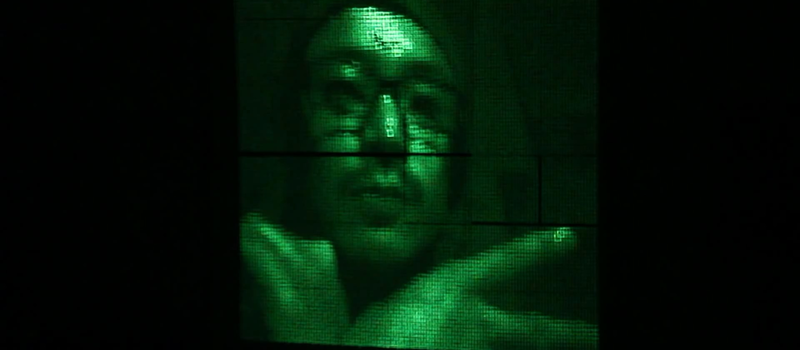Here’s a simple and interesting idea that increases the visual persistence of a laser scanner image. Using glow-in-the-dark paint, [Daito Manabe] prepares a surface so that the intense light of a laser leaves a trace that fades slowly over time. He’s using the idea to print monochromatic images onto the treated surface, starting with the darkest areas and ending with the lightest. The effect is quite interesting, as the image starts out seeming quite abstract but reveals its self with more detail over time.
As evidenced in the test videos, the bursts of laser scanning are matched to the fade rate of the paint. Therefore it would seem that the time taken to “write” an image is directly proportional to the desired visual persistence of the final image. We wonder, by combining clever timing and variable laser intensity could you write images much more quickly? How hard would it be to use this for moving pictures? With the ability to create your own tiny laser projector, and even an RGB scanner, there must be a lot of potential in this idea for mind-blowing visual effects. Add portability by using a phosphor-treated projection screen!
Share your ideas and check out the test videos after the break.
[youtube=http://www.youtube.com/watch?v=FUa9UgAZTIY&w=470]
[youtube=http://www.youtube.com/watch?v=Mt_4mfuwTAU&w=470]
















Ooooh. Now redo Tron with this method. :D
Very Cool
Not sure which is cooler, the effect or the sound.
HaD is a little slow, no?
http://www.liveleak.com/view?i=9e7_1285076610
I’m curious about the scanning/drawing algorithm in the second video. Does it look familiar to anyone?
What is it with the lame gang signs crap?
I don’t understand what this is at all. What kind of laser scanner are you talking about?
Oh god that sound’s awesome.
I am curious, what happens if you pop a flash after it starts to fade, would it lighten the entire scene evenly, keeping the picture? That is, if a flash adds an equal amount of energy throughout, it would be like a brightness control of the scene.
This is an old idea.
http://lm741.posterous.com/new-footage
neat!
sounds like a logical extension of the UV POV display made from an old scanner and UV LEDs.
wonder if a variant of this would work using a spinning HDD platter (an old steam driven 5 1/4″ quantum fireball would work well) and glow in the dark sticky plastic sheet from an exit sign?
also you can “quench” it by shining IR light on the phosphor.
-ZPM
This is similar in principle to how a CRT display works.
Energizing phosphors with a sweeping beam.
I noticed that a green laser also erases (quenches) to glowing parts. Perhaps it is IR leaking through the filter?
Using quenching, you could use a flash to activate the entire phosphor, then selectively erase with a green laser (or IR laser)…
P.S. What’s with all the “old news” crap? Hackaday brings cool hacks to the attention of HaD readers. Since when is there a freshness date on coolness?
Dude !! The second video is awesome !
A startup for Laser Video Projection… great circuitry with lcos mirror… at this point i’m stucked at laser polarization trhough micra mirrors… https://sites.google.com/site/chewe3d/Projectes/laserprojector
cool, i like the sound too
+1 on cool sound :D
Could he use an infrared laser so you don’t see the laser flashes, make it more mysterious, and this could also be used with huge pieces of photographic paper to make pictures.
@Hirdinea:
As reported above, an IR laser quenches (erases) the glowing phosphorescence. This method is used some IR image converters. Focus IR image on ZnS phosphor plate, which quenches it and affects its sensitivity, bias the ZnS with UV, which creates a negative visible image which is scanned by vidicon or CCD imager. Of course, a germanium lens to focus the IR is not cheap. The modern approach is to replace the phosphor with organic films on glass:
http://redshiftsystems.com/site/TechnologyProducts/OpticalThermalImaging/tabid/54/Default.aspx
Tech Challenge #2: Who will make a cheap DIY thermal imager using phosphorescent quenching?
Here they are doing thermal imaging using the temperature-dependent phosphorescence intensity of the rare earth chelate Eu-TTA (europium (III) thenoyltrifluoro-acetonate) thermosensitive dye:
http://www.cell.com/biophysj/abstract/S0006-3495(98)77769-0
This seems like a project for Jeri Ellsworth, unless somebody beats her to the punch. ;-)
WooHoo! It’s one of the best lo-fi hacks i’ve ever seen! :-)
I agree with Ken; this is CRT without the CRT.
On a related note, there is a similar idea to what was mentioned about flashes in the Ripley’s Believe It Or Not museum in St. Augustine, FL.
@Hirdinea: already been done
http://en.wikipedia.org/wiki/LightJet